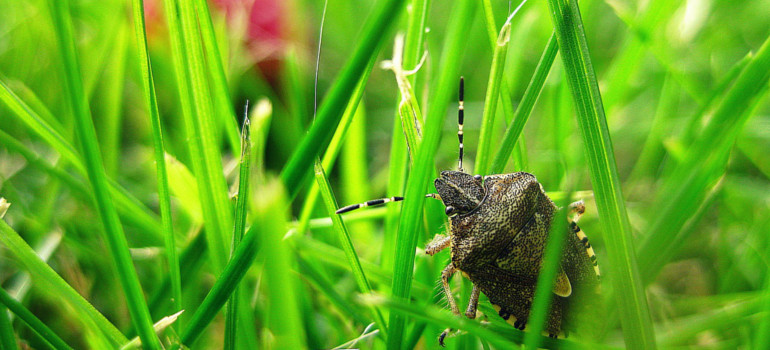
With autumn upon us, many homeowners have begun preparing their homes for winter. But it is not only humans that are in preparation mode, a lot of insects are also looking for somewhere warm and dry to live until the winter months pass.
A common sight in homes and gardens across the country at this time of year is the annoying and smelly stink bug. These little-armoured beetles happily stay out of the way for most of the year, but when it gets colder they seek shelter in our comfortable, heated houses.
Table of Contents
What are stink bugs?
Stink bugs are a member of the Pentatomidae family of beetles and are quite distinctive, they have large shield-shaped bodies and are usually green or brown in colour.
Most species of stink bug only eat plants and can grow to a size of around 1cm, but there are also those which eat other garden-destroying bugs, such as aphids and caterpillars.
Although they are active throughout most of the year, you are more likely to spot them in the spring and autumn as these two periods are when they wake up or look for shelter.
Do stink bugs bite?
Stink bugs are not known for biting or stinging people, their small mouthparts aren’t strong enough to pierce our skin.
However, some people can experience a mild allergic reaction to the chemical they release, and prolonged exposure to their crushed remains can lead to dermatitis.
Do stink bugs stink?
Stink bugs indeed do stink. The stink bug is not undeserving of its name, these critters have an inbuilt defence mechanism to ward off potential predators and other threats. They all have a gland in their abdomen which holds a particularly pungent chemical, when they feel threatened or when you stomp on them they excrete this odorous substance.
Most types of stink bugs simply release a small amount of the terrible chemical but there are some which can spray it over several inches.
If you have never suffered through the ungodly stench produced by these armoured beetles, consider yourself lucky. While the smell is not as outrageous as rotten food or bad milk it is unpleasant, the general opinion of those who have experienced the dread of the stink bug stench liken the smell to that of overpowering herbs or strong cilantro.
As if that wasn’t bad enough, the odour can last for several hours even after cleaning so tread lightly unless you are fond of strong, smelly herbs.
Are stink bugs harmful to humans or pets?
As mentioned above, stink bugs are not particularly harmful to humans but in rare cases, they can cause an allergic reaction and even dermatitis if you have prolonged contact with their crushed remains.
As for pets, a lot of household animals see these small moving insects as small friends to play with and eventually snack on. However, stink bugs are slightly toxic to animals when eaten, the chemical defence system causes stomach irritation and vomiting.
This may sound serious but the vomiting usually passes within a day or two with no additional side effects, of course, if it lasts for several days or you see blood in the vomit of your pet anima, then you should take your furry friend to the vet as soon as you can.
Are you dealing with a pest infestation?
You don't have to be alone in the battle against pests. Hire a professional pest expert!
Call usWhat damage stink bugs can cause?
Despite being native to China, Japan, and Korea, the brown marmorated stink bug has made its way to the UK, resulting in significant damage to agriculture. They can quickly destroy crops, and since one bug can eat so many different plants, the losses can be huge.
The adult bugs and nymphs inject enzymes that can damage plant tissue and drain the juice from fruit crops.
While the bug may damage fruits and vegetables during the summer, it also has the potential to move inside people’s homes during the winter. They do not reproduce inside and don’t consume wood, so they cannot damage buildings structurally. However, that doesn’t mean they aren’t annoying.
How to get rid of stink bugs
Regardless of whether you use natural methods or an insecticide to get rid of the smelly creepy crawlies, you will need to quickly remove the carcasses as they will expel the entirety of their stink glands shortly after death.
(NOTE: We recommend against using an interior pesticide to combat stink bugs as they tend not to be as effective as natural methods, see below for more information on natural stink bug control methods.)
- Use soapy spray – Mix 1000ml of hot water with 180ml of liquid dish soap inside a clean spray bottle and apply this mixture to areas where stink bugs gather to keep them away or spray them directly. Stink bugs will die shortly after being sprayed as the soap disintegrates their protective shell and dehydrates them.
- Put them outside – If killing isn’t your style, consider starting a stink bug catch-and-release system. If the weather is cold enough the bugs will simply freeze and if it is milder there is a good chance predators will eat them. When capturing the little critters, use a plastic bag in order to avoid touching them directly and stinking up your fingers.
- Use a nicotine spray – Some people have had success at killing stink bugs by using a nicotine-based spray. To make this yourself, shred half a pack of cigarettes and soak them in warm water, after approximately one hour strain the mixture to remove the tobacco and add a few drops of liquid dish soap. Spray this mixture directly onto the pungent insects and wait for them to die.
- Use an empty water bottle – Take an empty water bottle and position it below the offending stink bug, using the bottle cap flick the bug into the bottle. Repeat this for every stink bug in sight and screw the cap on tightly. If it is cold enough simply put the bottle outside overnight, if not wrap the bottle in a plastic bag and put it in the freezer overnight. Dispose of the bottle the next day.
- Use a bucket of warm soapy water – Fill a bucket with warm water and mix in a few drops of liquid dish soap, place the bucket below any stink bugs you find and flick them into the water. The soap will make it impossible for the bugs to escape and they will drown shortly afterwards.
- Use your vacuum cleaner – Do not use this method if you own a bagless vacuum. This is the simplest method of getting rid of stink bugs, all you need to do is vacuum the bugs up and dispose of the hoover bag straight away. If you forget to throw the bag away you will very quickly notice a foul smell creeping throughout your home every time you use the vacuum cleaner.
- Use diatomaceous earth – This is an insect’s worst nightmare, diatomaceous earth is a naturally occurring compound made up of silica, aluminium, and iron oxide. It shreds the protective outer shell of insects leading to death by dehydration. Spread the diatomaceous earth powder around entry points such as doors and windows, and anywhere else the bugs seem to congregate.
Check also:
How to keep stink bugs out of your house
Now that you have gotten rid of those nasty little stink bugs you should consider taking steps to prevent them from entering your home in the first place.
- Seal entry points all possible entry points – Inspect the exterior of your home, paying special attention to the area around windows and doors, and seal any cracks or holes with caulk.
- Repair or replace window and door screens – Like most insects, stink bugs can enter your home through the smallest of holes. If you have window or door screens installed check them for damage and repair or replace them if needed.
- Turn off outdoor lights at night – Stink bugs are attracted to light, so if you have outdoor lighting make sure to turn it off in the evening.
- Control food sources – Pests tend to look for two things when searching for a winter home, warmth and a food source. Storing dry foods in airtight containers and cleaning any crumbs or pieces of food will make your home less appealing for these stinky beetles.
- Use a mint spray – Mint is a natural insect repellent, so bugs are not fond of the strong smell. Mix 500ml of warm water with ten drops of mint oil in a clean spray bottle and apply the mixture to possible entry points such as door frames, window frames, air vents, and anywhere stink bugs might hide.
Check also:
How to get rid of stink bugs in the garden
Usually, the vast majority of stink bugs will find their way into your home from the garden. Proper garden maintenance is essential for keeping all sorts of pests at bay, follow the tips below to keep the stink bug population in your garden under control.
- Use insecticides – While it is not advisable to use an insecticide indoors, using one in your garden can decimate the current stink bug population that is bugging you. You may have to spray your garden with insecticide every two to four weeks as the effects are not long-lasting. As usual, always read the instructions before using any insecticide.
- Keep your garden clean and free of debris – Piles of leaves and other general garden debris make for an excellent hideout for pests, disposing of any rubbish will deny insects the chance to establish a stronghold.
- Store wood at least twenty feet from your home – Your dry wood store is also a superb place for stink bugs and other pests to hide, plus they can hitch a ride indoors by clinging to the logs. If possible, store your wood at least twenty feet away from your home and make sure it is at least five inches above the ground.
- Attract stink bug predators such as ladybugs to your garden – Predatory bugs are a gardener’s best insect friend, these little helpers will actively seek out and destroy pests such as stink bugs and aphids. The best of these insect-hunters are ladybugs, spiders, and assassin beetles. You can either buy them from a garden centre or attract them with plants like dill, marigolds, and calendula.
- Use traps – Garden centres and home DIY stores stock a wide variety of insect traps. If you are facing a serious garden infestation placing a few of these traps around your property can drastically reduce the number of pests.
- Use trap plants – This method of pest control works by introducing plants that pests find irresistible to your garden, the pests will swarm these plants instead of others. Stink bugs are particularly partial to mustard, sunflowers, and sweet corn, and as they gorge themselves all you have to do is cut the plants down, bag them up and dispose of the plants and bugs.
Frequently asked questions about stink bugs
What attracts stink bugs?
Stink bugs are usually attracted to homes because of light during the night, warmth, and the smell of ripe or decaying fruits and vegetables. However, they enter homes seeking shelter as temperatures drop in the fall and their survival chances outside severely drop. Human dwellings offer plenty of food and protection for stink bugs so it’s understandable why they want to get in.
What scents keep stink bugs away?
Scents like mint, garlic, and lavender are known to repel stink bugs. It has been said that using essential oils or sprays with these scents can help deter them from entering your home. However, keep in mind that these methods are not very reliable and they can actually be more costly than modern conventional means such as professional pest control that offers highly effective deterrence.
Why are there so many stink bugs in my house?
So if you are dealing with a lot of bed bugs indoors, then this means they have easy access to your property, perhaps through some unseen entry point. It would be best for you to carefully examine your home and figure out how the bed bugs enter. Blocking those entry points will severely drop the number of instances when bed bugs end up inside.
How long is stink bug season?
Stink bug season in the UK typically starts in late summer and lasts through early spring, with peak activity in the fall when they seek shelter indoors. During the warm months of the year, you might experience fewer instances when bed bugs enter your home simply because the conditions outside are more favourable for them.
Where do stink bugs nest?
Stink bugs do not build nests but instead hide in cracks, and crevices. Within a property, they usually opt for protected areas like attics, walls, and crawl spaces to overwinter. In nature, they seek shelter under tree bark, rocks, or other outdoor structures.

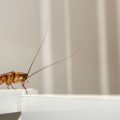


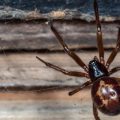
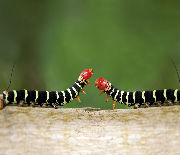
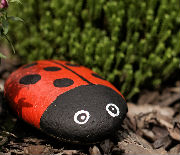
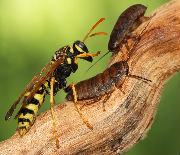
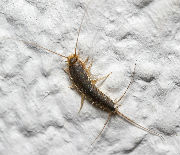
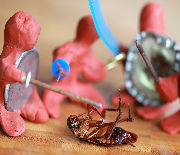
Leave a Reply